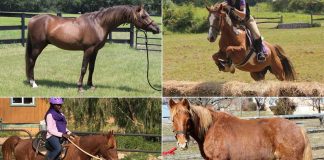 Q: I have two horses that live out in a pasture together and one has recently developed bald patches in her winter coat. I think this may be rain rot as she often doesn’t go in the barn when it rains. It is much too cold to bathe her right now. Is there another option to treat this?
Q: I have two horses that live out in a pasture together and one has recently developed bald patches in her winter coat. I think this may be rain rot as she often doesn’t go in the barn when it rains. It is much too cold to bathe her right now. Is there another option to treat this?
Treatment for mild rain rot is usually accomplished with topical therapy alone. To treat this condition, you actually would not want to bathe the horse, but rather do spot treatments on only the affected areas. Using an antibacterial shampoo such as a dilute chlorhexidine, iodine, or benzoyl peroxide solution on a sponge, gently soak the affected areas and remove the crusts. Then dry these areas completely with a clean towel. This should be done once or twice daily for about a week. This treatment accomplishes two important things: firstly killing the proliferating bacteria that are invading the skin, and secondly creating a dry environment to prevent bacteria from re-populating the area. If your horse has a particularly thick winter coat, the treatment will work best if you first clip the excessive coat away and then apply the soak. This will help when drying the affected areas as well.
In severely affected horses, systemic antibiotics may be warranted, as secondary bacterial infections may erupt. In cases such as these, or in horses with particularly sensitive skin, sedation may be required to thoroughly scrub and cleanse the affected areas.
As far as keeping your mare dry, if she won’t go into the barn, this may prove difficult. You may need to investigate reasons why she won’t go in the barn, taking into consideration situations where the other horse is bullying her, or if she’s fearful of something inside the barn, etc. You might consider body clipping her once or twice over the winter and blanketing her to keep her dry. If body clipping is not an option, then blanketing isn’t recommended since a heavy winter hair coat under a man-made coat will create more sweat and heat – prime conditions for bacteria to proliferate.
Other causes of patchy bald spots, or alopecia, on your horse include bacterial folliculitis and ringworm. Folliculitis, or inflammation of the hair follicle, is most commonly caused by bacteria of the Staphylococcus genus, which usually act as opportunistic pathogens that take advantage of a weakened immune system, skin trauma, or generally compromised, unhealthy skin tissue. Ringworm, or dermatophytosis, is a superficial fungal infection of the skin due to Trichophyton or Microsporum species of dermatophytes. Highly contagious between horses and people and very annoying but not life threatening, this skin condition usually manifests as irregularly round, hairless lesions typically around the face, legs, girth, and shoulders. Veterinary evaluation of your horse will confirm your suspicions of rain rot or perhaps turn up something else. Many times, the common equine skin conditions mentioned above are diagnosed merely by their clinical presentations. Occasionally, however, further diagnostics such as fungal and bacterial cultures, cytology, and skin biopsies are warranted.






It is good to know this advise before rainrot happens.
Thanks for the information.
thank you for answering my question! Luckily we have the vet coming out next week, as we haven’t had much success in treating it. I really like being able to have information on my mares situation before the vet comes.
My horse had rain rot. and it took almost a year to get rid of it. everything we tried at first wouldn’t clear it up
Another option if possible is to make a lean-to for the horse to get out of the rain. Even horses that don’t go into barns will use a lean-to, unless they’re REALLY perverse. 😉
Great advice. BTW, how do we ask questions?
Interesting article. My horse has never had rain rot but it will prove helpful if he get it
While reading this I think my mares might have had a touch of rain rot this past year. Is there any way of preventing this condition in animals which are not in a barn at all? I have blankets for them all which I use when one starts to show signs of stress. Mostly they remain uncovered. This year, to cover them in rain would have meant covering them about 90% of the time.